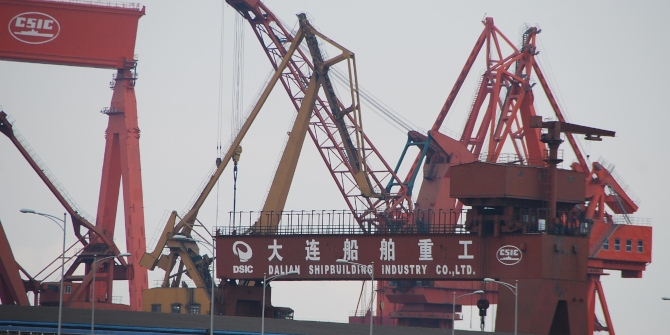Despite the increasing foreign investment in many African economies, their participation in trade, and the economic growth that follows from it, structural transformation has remained limited. Kasper Vrolijk takes a look at Ethiopia’s industrial policy and argues that the government has failed to sufficiently emphasize innovation in—and technology transfer to—domestic firms, leading to minimal “upgrading” of low to high value-added activities.
Many African economies experienced exponential growth in consumption, investment and production in the last two decades. As a result, the Economist termed Africa “a hopeful continent” and spoke of “Africa Rising”. Unfortunately, these growth statistics and this denomination provided an improper characterisation of events. Diversification in production and export sectors remained minimal, growth in the industrial sector was largely non-existent, and workers in the agricultural sector ended up in the less-productive services sector, instead of the productive industrial sector. As a result, there was a minimal increase in effective employment (with fair wages) and limited decreases in poverty.
In order to bring about structural changes, many African governments turned to “industrial policies”. Whereas previously active government intervention in economic markets was rejected in view of possible corruption and rent-seeking, many policymakers perceived it necessary and efficient to actively push for economic development in Africa. For example, many governments used direct subsidies and other incentives to promote specific sectors, participate in global supply chains and attract foreign investment. Despite this change in policy, in a recent paper I present new evidence that these industrial policies have been inefficient and do not contribute to the structural transformation of African economies.
Insights from Ethiopia
One example of an African economy using extensive industrial policy to promote structural transformation is Ethiopia, which is among the fastest growing economies in Africa. An important driver of this growth was the Growth and Transformation Plan (GTP), a new policy that the government introduced in 2010 and renewed in 2015. In contrast to the policies that existed at the time, which focused mainly on poverty reduction and sustainable development, the GTP aimed specifically at supporting economic growth and the structural transformation of the economy. As a result, the Ethiopian government introduced both a broader macroeconomic framework to attract foreign investment, as well as sector-specific strategies for key sectors, such as the cut-flower and leather industry.
Despite the rapid growth it achieved – gross domestic product (GDP) remained largely above 10% over the past decade – the structural transformation of the economy failed to materialize. The share of the industrial sector in GDP grew from 10.3% to 12.4% between 2010 and 2013, although the share of the services sector also increased (from 44.1% to 45.2%), while much of GDP remained driven by the agricultural sector (42.9% in 2013). In reality, large part of economic activity remained concentrated in low value-added production, such as the agricultural sector. Ethiopia’s exports have also remained broadly unchanged over the last decade and foreign investment diversified only minimally into high value-added sectors.
I argue a possible cause for this phenomenon: The Ethiopian government uses industrial policy to increase output, and thus manages to achieve temporary economic growth, but does not emphasize innovation and technology transfer sufficiently, which subsequently leads to minimal “upgrading” of low to high value-added activities.
In part, the limited transformation of the economy in Ethiopia is due to the inefficient implementation of industrial policies. For example, the GTP policy gave various tax incentives to domestic and foreign companies – such as the duty-free import of machinery and parts – but government did not implement all incentives fully or evenly. Among other things, customs were not fully aware of the policy on duty-free imports of machinery and spare parts, and although the government provided land, credit, and electricity within industrial zones, in some cases other infrastructure remained largely absent or unfinished.
These issues increased transaction costs for both domestic and foreign firms and reduced their competitiveness, but they were not the main cause of limited “upgrading”. The main reason was that the GTP policy hardly focused on incentives that increased technological innovation in domestic firms. Those firms that were part of a global subsidiary received knowledge and skills from the international head office and therefore faced fewer (or no) constraints from limited R&D incentives provided by the Ethiopian government. Domestic firms, however, often had no access to such skills and knowledge, and relied largely on self‐sustained efforts to attain skills and knowledge by attending national and international conferences, by insourcing foreign experts, and piecemeal organizational innovation in production processes.
In the second GTP policy, which was introduced in 2015, government paid extra attention to linkages between local and foreign companies to facilitate knowledge and technology transfer and to ensure the sustainability of growth. However, I find that government agencies, and bureaucrats within them, struggle to conceptualise and measure notions of technology, and as a result, to implement mechanisms that facilitate knowledge transfer. Although government has made technology transfer agreements for international investors, they are rarely used. Furthermore, support programmes to bring foreign experts into domestic manufacturing firms have been pursued only sporadically and randomly.
Solutions
There are three solutions to this problem. First, the Ethiopian government can improve the effectiveness of its policies by making minimal policy changes. At present, industrial policy in Ethiopia is not aligned with what firms need, government provides support that is not necessarily required (e.g., cataloguing available machinery), while at the same time omitting essential, cost‐effective and more valuable support (e.g., regulating technology transfer, systematising and funding foreign expertise into domestic firms).
Second, and to support these changes in policy, policymakers themselves must build capacities to effectively implement policies that support innovation and technology transfer in key sectors. Here is an important opportunity for other governments and their aid programmes to support the Ethiopian government, among other things by stimulating and financing knowledge transfer between policy officials in Ethiopia and other emerging economies (e.g., China and India).
Third, there is a major role for the business community. My research and a large scientific literature (example here) show that domestic firms, by working closely with international companies, can participate in innovation and technology transfer, and thereby increase employment and productivity.
♣♣♣
Notes:
- This blog post is based on Industrial policy and structural transformation: Insights from Ethiopian manufacturing, Development Policy Review
- The post gives the views of its authors, not the position of LSE Business Review or the London School of Economics.
- Featured image: Addis Ababa light rail vehicle, by Turtlewong, under a CC0 1.0 licence
- When you leave a comment, you’re agreeing to our Comment Policy






Well analyzed. However the poverty reduction the last 20 years should also be recognized. But sure, there is still a long way to go
Interesting insight on knowledge and technology transfer. As the author indicated without such transfers, its just selling Ethiopia’s cheap labor for with no other gain to the economy. This will lead to a dead end. Other option is to make such transfer mandatory and with concrete incentives.
One big issue but lack of strategic thinking and vision for both the industry and workers and modeling after other countries that may have very little similarity to Ethiopia maybe an issue. The communities where these industry’s are located may have a better livelihood csolution, engaging the locals as stakeholders may be an issue as well. These are all theories of course
The economy is the beginning and end of everything. You can’t have effective training change or some other change in the event that you don’t have areas of strength economy.